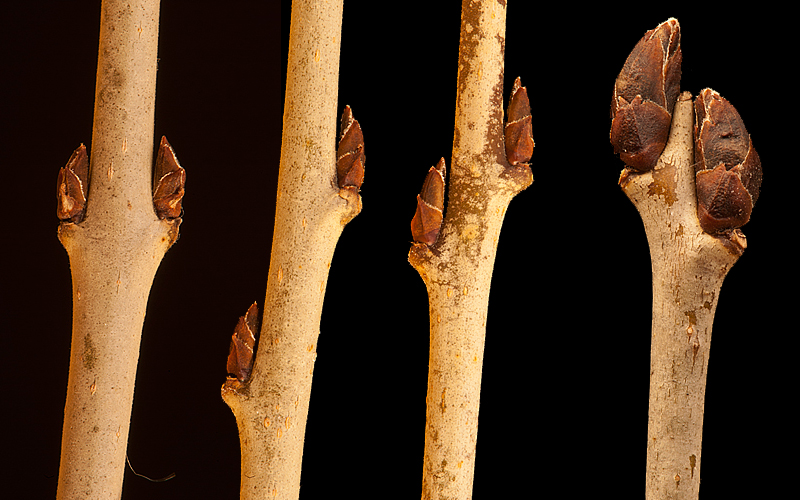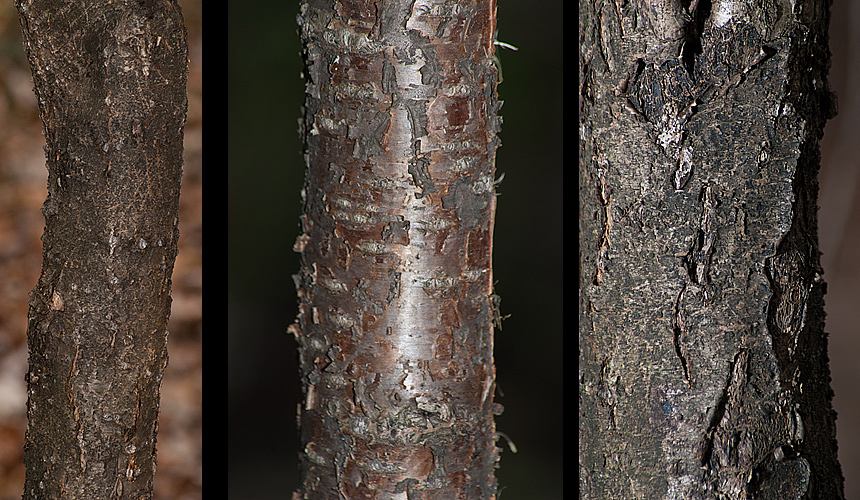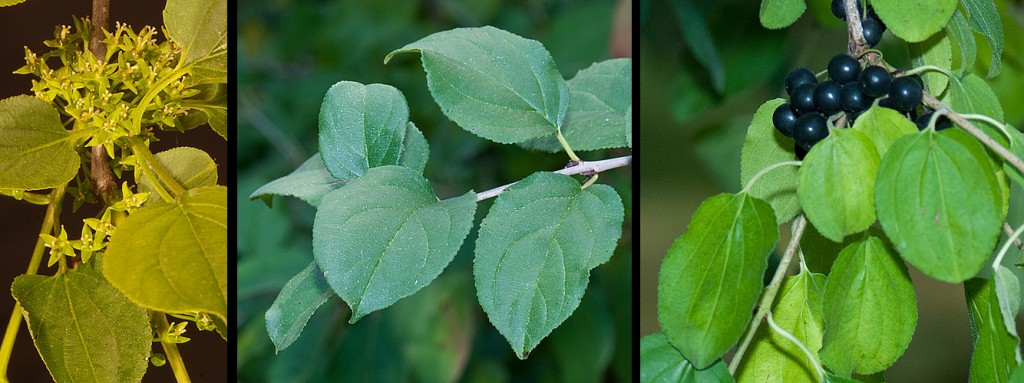Common Buckthorn, also called European Buckthorn, (Rhamnus cathartica) was first collected in Michigan in 1914 but reported by Beal in the 1904 Michigan Flora. Billington in his Shrubs of Michigan, published in 1949, still recommends this species as “an excellent hedge plant;” although, he does admit that the “seeds do germinate easily” and they “create a green carpet under the bushes.” This invasive species should never be planted.
An aggressive invader of many habitats in Michigan, this shade tolerant shrub is choking out many native species. While distributed throughout the state, it is common only in southern Michigan, but seems to be spreading in northern Michigan.
It is one of the the first species to leaf out and one of the last to drop its leaves, resulting in a long growing season and giving it an advantage over our native species. The plants are allelopathic, meaning they inhibit the germination of other species. Their fruit is largely responsible for this characteristic so once the species becomes established it aggressively colonizes the habitat. I have seen colonies of Common Buckthorn that have one large “mother-tree” in its center. The seeds are also epigeal, meaning that they germinate on the ground without having to be buried. This allows large numbers of them to germinate.
The twigs are tipped with a thorn slightly longer than the buds. The buds, and hence the leaves, are sub-opposite but opposite and alternate nodes occur. The nodes shown in the photo are three successive nodes on the same twig. The thorns occur along the branches and are sharp. These distinguish the plant from Wild Black Cherry, and Choke Cherry.
The bark resembles the bark on a Wild Black Cherry but Buckthorn Bark is often redder. Choke Cherry bark is also similar but the lenticels (the large pores) are more prominent in the cherry. If you have doubts, then peel a little of the bark away from a branch and look for the orange inner bark. Most Common Buckthorns have this bark.
The leaves are slightly folded, with fine teeth and 3-5 pairs of prominent recessed veins. They are normally a dark green.
The flowers have four yellow-green petals. Male and female flowers occur on different trees and the female trees outnumber the males. A few male trees in a given population can produce enough pollen to pollinate a large colony. I checked 60 shrubs in one colony looking for male flowers to photograph and could not find any. This same colony heavily fruited that year indicating there was no shortage of pollen.
The fruit is a three to four seeded drupe that is eaten by birds. A drupe is a fleshy fruit that surrounds a hard pit or pits. Cherries are an example. Most Common Buckthorns fruit heavily, so once a few plants begin to colonize an area it can rapidly take over. The seeds remain in the seed bank for a relatively short period (three to five years). After we cut a large stand in Royal Oak, Michigan, seedlings continued to appear for the next three years.
Michigan Natural Features Inventory has an excellent site on Common Buckthorn.
Copyright 2013 by Donald Drife
Webpage Michigan Nature Guy
Follow MichiganNatureGuy on Facebook





I first read about this plant in the Hasting’s Reminder. Wanted more info as we have 20 acres. Visited numerous sites, including Extension and DNR sites. Yours is by far the most comprehensive, informative, detailed and user-friendly with really useful pictures. I’ll be returning for sure to research other info. Thank you Nature guy!
As I read more I have two questions:
* How tall does it grow/diameter of trunk?
* Is this the same as the Glossy Buckthorn?
Thanks
Linda,
The Common Buckthorn is a large shrub or small tree. It is not the same as Glossy Buckthorn. Glossy Buckthorn is also a Eurasian native, Frangula alnus, which is invasive here in southern Michigan. In my experience it is even more invasive than Common Buckthorn.
The Michigan Nature Guy
Pingback: Glossy Buckthorn in Michigan | The Michigan Nature Guy’s Blog
This is a terribly wicked plant. Been battling the few in my yard for a few years now trying to eliminate it.
Just FYI – I haven’t found any information on it being toxic, however i have noticed that the slightest prick of the thorns causes a painful pus filled bump where it contacts. Maybe its just an allergic reaction but just be forewarned readers that this might happen to you.
Buckthorn is both nasty and hard to get rid of. It is an allelopathic plant, meaning that it is toxic to other plants. It is not normally toxic to people, but some people are allergic to it, just as some people are allergic to Cherry.
The Michigan Nature Guy
I work in land conservation and battle buckthorn every day. I’ve taken books out of the library and done lots of Internet research and I find a lot of conflicting information on buckthorn identification. This has been very informative, but is there any way you can write one on glossy buckthorn also, or maybe point me in the direction of some good information? When you get out in those woods, with all the different maturity levels, your eyes start playing tricks on you!
Nevermind- I found your article 🙂
Pingback: Our Native Buckthorn | The Michigan Nature Guy’s Blog
Love your site and information. I find more plants I cannot identify here as opposed to other sources which should be reliable, but are not. Thanks for your efforts to expand the educational base with good material and excellent pictures.
I recently removed one of these trees on my city lot. On two occasions in handling the wood without gloves and both occasions I have gotten some fingertip pain and sensitivity only on one hand. Just wondering if there are any toxins in the bark or sap that could cause this effect.
I have never heard of someone having a reaction to buckthorn. However, individuals can be allergic to many things. I normally wear gloves when I handle it for protection from the rough bark and thorns.
Yikes! I was looking for a hedge for privacy and my landscaper planted 5 tall hedge buckthorns last summer. I guess I need to get rid of them.
we’ve had luck with the cut stump/spray method for our larger trees, but have hundreds if not thousands of buckthorn seedlings. Pulling them does bring up a lot of soil, with all the crappy seeds (garlic mustard, honeysuckle, and more buckthorn). Spraying the seedlings just makes them mad, but they come back the following year. So my question is for seedlings, when there are a lot of them…. Do I have to cut each one and spray the cut area? When is the best time to do this?
Julie,
I have no experience treating Buckthorn seedlings. I would check the DNR website https://mnfi.anr.msu.edu/invasive-species/CommonBuckthornBCP.pdf or other invasive species control pages. Sorry.